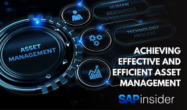SAP Asset Accounting
Filter By
Browse By
- SAP Analytics and AI
- SAP Application Development and Integration
- All SAP Application Development and Integration
- SAP ABAP
- SAP ABAP Development Tools
- SAP ABAP Test Cockpit
- SAP API Management
- SAP BAPI
- SAP Basis
- SAP BRF
- SAP Business Application Studio
- SAP CMS
- SAP Design Studio
- SAP Development Tools
- SAP DevOps
- SAP EAI
- SAP EDI
- SAP Extension Suite
- SAP Fiori
- SAP Fiori Elements
- SAP Integration Suite
- SAP Low Code Application Development
- SAP Low Code Automation
- SAP Netweaver
- SAP Release Management
- SAP UI5
- SAP Web Application Server
- SAP Web IDE
- SAP Business Process Management
- SAP Center of Excellence
- SAP CIO
- SAP Customer Experience
- SAP Data and Data Management
- All SAP Data and Data Management
- SAP BW
- SAP BW/4HANA
- SAP Crystal Reporting
- SAP Data Archiving
- SAP Data Center
- SAP Data Governance
- SAP Data Integration
- SAP Data Migration
- SAP Data Quality
- SAP Data Services
- SAP Data Strategy
- SAP Data Visualization
- SAP Data Warehouse Cloud
- SAP DMS
- SAP Document Control
- SAP EIM
- SAP ETL
- SAP ETL Tools
- SAP HANA
- SAP HANA Administration
- SAP HANA Deployment Infrastructure
- SAP HANA Studio
- SAP Master Data
- SAP Master Data Governance
- SAP MDM
- SAP Enterprise Architect
- SAP Enterprise Asset Management
- SAP ERP
- SAP Finance
- All SAP Finance
- SAP Accounting
- SAP AR AP
- SAP Asset Accounting
- SAP Billing Systems
- SAP BPC
- SAP BRIM
- SAP Cash Management
- SAP Central Finance
- SAP Controlling
- SAP COPA
- SAP Cost Center Accounting
- SAP e-invoicing
- SAP FICO
- SAP Finance Automation
- SAP Financial Closing Cockpit
- SAP Financial Consolidation
- SAP Financial Planning
- SAP FX Risk
- SAP General Ledger
- SAP Global Tax Management
- SAP Hyperion
- SAP Order to Cash
- SAP Payment Processing
- SAP Profitability Analysis
- SAP Rebate Management
- SAP S/4HANA Finance
- SAP Universal Journal
- SAP Governance Risk and Compliance
- SAP Human Capital Management
- SAP Intelligent Technologies
- SAP Platform and Technology
- All SAP Platform and Technology
- SAP Business Technology Platform
- SAP Cloud Connector
- SAP Cloud Integration Platform
- SAP Cloud Migration
- SAP Cloud Platform
- SAP Cloud Providers
- SAP Cloud Strategy
- SAP Container Platform
- SAP Digital Asset Management
- SAP Digital Integration Hub
- SAP Digital Signature
- SAP HANA Enterprise Cloud
- SAP HEC
- SAP Hyperscalers
- SAP Infrastructure
- SAP Messaging
- SAP Smart Forms
- SAP Quality and Testing
- SAP Security
- SAP Spend Management
- SAP Supply Chain Management
- All SAP Supply Chain Management
- SAP APO
- SAP Asset Management
- SAP Business Network
- SAP Digital Manufacturing Cloud
- SAP Digital Twin
- SAP EWM
- SAP IBP
- SAP Inventory Management
- SAP Label Printing
- SAP Logistics
- SAP Manufacturing
- SAP Manufacturing Automation
- SAP MES
- SAP MII
- SAP MM
- SAP MRO
- SAP MRP
- SAP Order Management
- SAP Plant Maintenance
- SAP PLM
- SAP Production Planning
- SAP S&OP
- SAP SD
- SAP SPM
- SAP Supply Chain Planning
- SAP Track and Trace
- SAP Transportation Management
- SAP System Administration
What is SAP Asset Accounting?
SAP Asset Accounting is a submodule of the SAP Financial Accounting (FI) module within SAP ERP that handles the management and supervision of an organization’s fixed assets. The fundamental goal of finance and accounting managers utilizing SAP Asset Accounting (FI-AA) is to track the acquisition, utilization, depreciation, and disposal of assets and determine the exact values of the company’s fixed assets on a given date. This includes everything from purchases and sales, rental income generated by properties owned by companies and other organizations, as well as any repairs, enabling customers to manage their physical assets.
What is SAP Asset Accounting?
SAP Asset Accounting is a submodule of the SAP Financial Accounting (FI) module within SAP ERP that handles the management and supervision of an organization’s fixed assets. The fundamental goal of finance and accounting managers utilizing SAP Asset Accounting (FI-AA) is to track the acquisition, utilization, depreciation, and disposal of assets and determine the exact values of the company’s fixed assets on a given date. This includes everything from purchases and sales, rental income generated by properties owned by companies and other organizations, as well as any repairs, enabling customers to manage their physical assets.
Key capabilities of SAP Asset Accounting include:
- Automated depreciation calculation and reporting
- Segregation of duties between accounting and operations
- Robust security features
- Integration with SAP ERP and other SAP solutions
- Flexible asset valuation
Key Considerations for SAPinsiders
Evaluate needs for parallel reporting in SAP S/4HANA to support SAP Asset Accounting. The new features in SAP S/4HANA Finance significantly change how the FI-AA module must be set up when using local or group reporting to enable reporting with different fiscal year variants.
Consider utilizing SAP Asset Accounting to enable flexible asset valuation. SAP Asset Accounting in SAP S/4HANA Finance makes it easier to track assets and their transactions, so multinational organizations can better understand how much value they have tied up in fixed assets. Charting depreciation supports transaction data at the country level, allowing for complex asset valuation and depreciation processes.
Limit customizations with enhanced SAP Asset Accounting standard functionality in SAP S/4HANA. Maintaining compliance across multiple areas is difficult for any organization and often results in highly customized systems that are costly to maintain. Standard features in SAP Asset Accounting in SAP S/4HANA can help streamline core asset accounting processes, including tax depreciation, and enable comprehensive drill-down capabilities to reduce the need for highly customized reporting or functions.
785 results
-

- SAP S/4HANA
 Premium
Premium
SAP S/4HANA Adoption: Subsequent Implementation of the Parallel Ledger
Reading time: 29 mins
Learn various SAP S/4HANA adoption options available for companies running the classic General Ledger. Follow steps to introduce the ledger subsequently in a live SAP S/4HANA system. Key Concept SAP introduced the parallel ledger concept with the SAP ERP Central Component (ECC) system in 2005, and since then, it is gaining popularity due to its…...…
-

SAP S/4HANA Adoption Tips
Reading time: 24 mins
Learn various SAP S/4HANA adoption options available for companies running the classic General Ledger. Follow steps to introduce the ledger subsequently in a live SAP S/4HANA system. This content is for Basic Access, SAPinsider Monthly Subscription, SAPinsider Annual Subscription, and SAPinsider Premium Annual Subscription members only.Log In Join Now
-

 Premium
Premium
Improve Your Asset Reporting with Two Overlooked Tools
Reading time: 9 mins
Preview this excerpt from Thomas Michael’s SAP PRESS book Reporting for SAP Asset Accounting to see some key reporting features in Asset Accounting (FI-AA). The book reviews both the various kinds of standard reports available and some important reporting tools that users often overlook. Key Concept Simulation versions are functions that allow you to consider…...…
-
-

 Premium
Premium
AUC with Investment Measure Using Work Breakdown Structure
Reading time: 20 mins
FinancialsLearn how to implement assets under construction (AUC) with the Investment Management module using work breakdown structure (WBS). Follow a detailed discussion of the settlement process. Key Concept A work breakdown structure (WBS) element with its assets under construction (AUCs) can be termed as an investment measure. In simple terms, an AUC is created to…...…
-

 Premium
Premium
How SAP ERP Combats the Challenges of Global Accounting and Financial Reporting Standards
Reading time: 16 mins
Review some SAP ERP solutions, functionalities, and capabilities that you can use to meet the challenges of specific International Financial Reporting Standards (IFRS) and International Accounting Standards (IAS) requirements, including ones that cover revenue, accounting policies, operating segments, and more. Key Concept International Accounting Standards (IAS) and International Financial Reporting Standards (IFRS) guide global financial…...…
-

 Premium
Premium
Capitalize Assets with Budget Monitoring Using Statistical Internal Orders
Reading time: 9 mins
See a method of direct capitalization with budgetary control that eliminates the need to post to the internal order and settle it. This method is best suited for simple budget monitoring of certain groups of assets — for example, lump sum budgets for furniture and fittings. Key Concept In an SAP system, assets are capitalized…...…
-

 Premium
Premium
Use Depreciation Below Zero Net Book Value for Better Product Costing
Reading time: 20 mins
Many organizations face scenarios in which they have some assets used even after the net book value (NBV) reaches zero. Once the NBV reaches zero, no more booking happens in accounting for legal reporting. However, from a management point of view, the depreciation needs to be accounted into cost estimation even if the NBV is…...…
-
-

 Premium
Premium
Streamline Your Parallel Accounting with the New G/L Ledger Solution
Reading time: 12 mins
See how to set up parallel accounting with the ledger solution in the new G/L with three procedures: ledger definition, currency valuation, and asset accounting. Key Concept Many international companies are subject to several sets of laws requiring them to issue multiple consolidated financial statements according to various accounting standards. In Europe, all publicly traded…...…
-

- SAP Enterprise Asset Management
 Premium
Premium
Achieving Effective and Efficient Asset Management
Reading time: 11 mins
In heavy asset intensive industries from manufacturing and processing facilities through to Rail, Aerospace, Utilities, Oil & Gas and Mining operations, the largest operational expense beyond the CAPEX of building the plant resides in maintaining the equipment required to do the job. This content is for SAPinsider Monthly Subscription, SAPinsider Annual Subscription, and SAPinsider Premium…
-

- SAP Billing Systems
 Premium
Premium
Tips for Integrating SAP Revenue Accounting and Reporting and SAP Hybris Billing
Reading time: 15 mins
Learn how to integrate SAP Revenue Accounting and Reporting 1.2 with Convergent Invoicing of SAP Hybris Billing and SAP Contract Accounts Receivable and Payable (FI-CA) in SAP ERP Central Component (ECC). Key Concept SAP Revenue Accounting and Reporting is a free add-on product introduced to help companies comply with the International Financial Reporting Standards (IFRS)…...…
Featured Insiders
-

Rahul Goyal
Sr Director, ERP & HRIS Systems
-

Suitao Yang
Senior Consultant, Deloitte
-

Tammy Powlas
SAP S/4HANA, Data & Analytics, AI & Machine Learning
Business Analyst/SAP Mentor - Fairfax Water
Become a Member
Unlimited access to thousands of resources for SAP-specific expertise that can only be found here.
Upcoming Events
-

Register Now: SAPinsider Technovation Summit Barcelona: AI + SAP BTP
May 14 - 15, 2024
Barcelona, Spain
View Event
Related Vendors
Your request has been successfully sent

